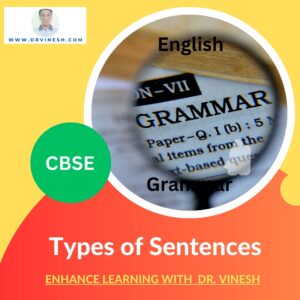Types of Sentences in English Grammar
Table of Contents
Introduction (Types of Sentences)
Sentences are the building blocks of communication. They allow us to express thoughts, convey information, and connect with others. But did you know that not all sentences are created equal? In the vast realm of language, sentences come in different types, each with its own structure and purpose. Understanding these types can greatly enhance your writing skills, add variety to your sentences, and make your message more impactful.
In this comprehensive guide, we will explore the various types of sentences, and their unique characteristics, and provide examples to illustrate their usage. So, let’s dive in and unlock the secrets of sentence diversity!

Types of Sentences:
1. Declarative Sentences
Declarative sentences make straightforward statements or convey information. They end with a period and are the most common type of sentence. Declarative sentences provide facts, express opinions, or describe situations. For example:
- “The sun shines brightly.”
- “I love spending time in nature.”
- “She is a talented musician.”
Declarative sentences serve as a foundation for conveying information in a clear and concise manner.
2. Interrogative Sentences
Interrogative sentences are used to ask questions and elicit information. They typically begin with question words (who, what, when, where, why, how) or with a verb inverting the subject and the verb. Interrogative sentences end with a question mark. For example:
- “Where is the nearest library?”
- “What time does the concert start?”
- “Why did you choose that book?”
Interrogative sentences help us gather information, seek clarification, or engage in conversations.
3. Imperative Sentences
Imperative sentences give commands, make requests, or offer instructions. They often begin with a verb and end with a period or an exclamation mark, depending on the intensity of the command. Imperative sentences can be direct or polite. For example:
- “Close the door, please.”
- “Study hard for your exams!”
- “Take a deep breath and relax.”
Imperative sentences allow us to assert authority, give guidance, or make appeals.
4. Exclamatory Sentences
Exclamatory sentences express strong emotions, surprise, or excitement. They convey heightened feelings and end with an exclamation mark. Exclamatory sentences often begin with “how” or “what” and are characterized by their enthusiastic tone. For example:
- “What a beautiful sunset!”
- “How amazing this performance is!”
- “I can’t believe we won the game!”
Exclamatory sentences help us convey our emotions and add emphasis to our expressions.
5. Conditional Sentences
Conditional sentences express hypothetical or imagined situations and their potential outcomes. They consist of two clauses: the “if” clause (the condition) and the main clause (the result or consequence). Conditional sentences can be categorized into different types based on the likelihood of the condition and its result. For example:
- Zero Conditional: “If it rains, the ground gets wet.”
- First Conditional: “If you study hard, you will pass the exam.”
- Second Conditional: “If I had more time, I would travel the world.”
- Third Conditional: “If she had listened to my advice, she wouldn’t have made that mistake.”
Conditional sentences allow us to explore hypothetical scenarios and their implications.
6. Compound Sentences
Compound sentences are formed by joining two or more independent clauses (complete sentences) using coordinating conjunctions like “and,” “but,” “or,” “so,” or “yet.” These sentences add complexity and variety to our writing. For example:
- “She loves to sing, and he enjoys playing the guitar.”
- “I wanted to go for a walk, but it started raining.”
- “You can have the cake, or you can have the ice cream.”
Compound sentences enable us to connect ideas, show contrast, or express choices.
7. Complex Sentences
Complex sentences consist of an independent clause and one or more dependent clauses. Dependent clauses cannot stand alone as complete sentences and rely on the independent clause to make sense. Complex sentences add depth and sophistication to our writing. For example:
- “After I finish my work, I will go for a run.”
- “Because she studied hard, she aced the exam.”
- “Although it was raining, they decided to go for a picnic.”
Complex sentences allow us to show relationships, and provide context, or present conditions.
8. Compound-Complex Sentences
Compound-complex sentences combine elements of both compound and complex sentences. They contain two or more independent clauses and at least one dependent clause. Compound-complex sentences offer versatility and allow for more intricate expressions. For example:
- “She went to the store, but she forgot to buy milk because she was in a hurry.”
- “He enjoys reading books, and he often visits the library when he has free time.”
Compound-complex sentences enable us to convey multiple ideas, show relationships, and express complex thoughts.
By understanding and incorporating these different types of sentences into your writing, you can add richness, clarity, and variety to your expressions. Experiment with sentence structures, combine different types, and adapt them to suit your intended meaning and style.
In conclusion, the diversity of sentence types provides us with a powerful arsenal to communicate effectively. Whether you want to make statements, ask questions, give commands, express emotions, or explore hypothetical situations, each type of sentence serves its unique purpose. Mastering the art of using these sentence types will elevate your writing, captivate your readers, and enhance your overall communication skills.
So, go ahead and experiment with these sentence types in your writing. Embrace the power of sentences, unleash your creativity, and watch your words come to life!
Instructions: Read each sentence and determine its type (declarative, interrogative, imperative, exclamatory, conditional, compound, complex, or compound-complex). Write the corresponding type in the space provided.
Worksheet for Practice
- Are you coming to the party? Type: ______________
- The cat chased the mouse. Type: ______________
- Please pass me the salt. Type: ______________
- What a beautiful day it is! Type: ______________
- If it rains, we will stay indoors. Type: ______________
- He loves playing soccer, but she prefers basketball. Type: ______________
- After finishing his homework, he went to the park. Type: ______________
- Take a deep breath and count to ten. Type: ______________
- She studied hard, so she earned good grades. Type: ______________
- Although he was tired, he didn’t give up. Type: ______________
Answers:
- Interrogative
- Declarative
- Imperative
- Exclamatory
- Conditional
- Compound
- Complex
- Imperative
- Compound
- Complex
This worksheet will help you practice identifying the different types of sentences and reinforce your understanding of their characteristics. Enjoy exploring the world of sentences!
Further Reading Suggestion:
The Book “MIDDLE SCHOOL ENGLISH GRAMMAR AND COMPOS” Written by Wren and Martin Click Here
Support Us: Support our cause and make a contribution through UPI payment methods like Google Pay, Phone Pay, or Paytm. Your support goes a long way in helping us make a positive impact.
UPI Payment (Google Pay/Phone Pay/Paytm)

Read also
CTET Exam 2023: Exam Date, Paper Format and Eligibility
College Admission Process in India: A Roadmap to Higher Education
After Admission Problems of a Student
How to Best Utilize Your Study Holidays: 15 Effective Ways
Career Options after Graduation in 2023: Exploring the Pathways to Success
12 Easy Tips to Study Consistently for long hours
How to Make Science Projects: A Step-by-Step Guide
Best Stationary Items for Students: All Essentials for Academic Success
Front Page for Projects: Making a Powerful First Impression
First Aid Beauty: Your Go-To Guide for Effective Skincare Solutions.
What is a Mole in Chemistry: The Remarkable Significance of the Mole
Types of Sentences: Unlock Diversity of Sentence Structures with Worksheet
How to Get Good Grades in Exams: A Comprehensive Guide
Significant Figures: Boost and unlock your 360 Degree performance
How to Score Full Marks in Exams: 6 Proven Strategies
How to study chemistry? 17 Proven Strategies to Master Chemistry
Best Reference Books For Class 10 CBSE Students
Types of Sentences: Unlock Diversity of Sentence Structures with Worksheet
The 8 Parts of Speech: A Comprehensive Guide to Understanding English Language
General Knowledge Questions with answers Part-1: Journey into the Unknown
General Knowledge Questions with Answers Part-2: Ignite Your Mind